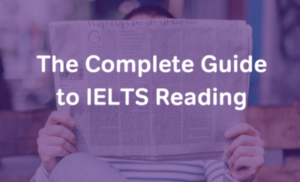

What is IELTS? Why is it important?
If you’re struggling to get the results you want on the IELTS Reading paper, you’re definitely not the only one. Many people find IELTS Reading to be very tough. The vocabulary alone is difficult, not to mention the wide variety of question types IELTS uses to measure your skills. Try not to get discouraged. Instead, get to work! Smart and consistent preparation can really pay off on IELTS Reading.
Guide to IELTS Reading
This Guide to IELTS Reading begins by covering some basic IELTS Reading information so you can become familiar with the test. However, this post mostly focuses on strategies and tips to help you perform better.
Whether you started preparing for the IELTS only recently, or you’re familiar with the exam already, this guide will give you the information and strategies you need to push your score even higher.
Table of Contents
IELTS Reading: The Basics
- Academic
- General Training
IELTS Reading Tips: Keys to Success
- Pacing
- Scoring
- Vocabulary
- Focus on the Directions
IELTS Reading Tips: Strategy
- Strategy 1
- Strategies 2 and 3
- Strategy 4
IELTS Reading: Question Types and Reading Samples
- Multiple Choice
- True/False/Not Given
- Yes/No/Not Given
- Matching
- Sentence Completion and Short Answer
- Note, Table, Diagram, or Summary Completion
IELTS Reading: The Basics
There are two versions of the IELTS exam: Academic and General Training. If you don’t know already which version you need to take, check with the institution(s) to which you plan to apply. The Reading and Writing sections (but not Speaking and Listening) are quite different between the two formats. You don’t want to prepare for the wrong one!
The Academic and General Training Reading papers do share some features. For example, both take 60 minutes and contain 40 questions. Also, even though the Reading passages are quite different between the two exams, the strategy for answering questions is actually very similar. This is because the question types are generally the same on both versions.
However, the Academic and General Training Reading exams differ in some important ways. Let’s take a look at their unique features, along with some official IELTS questions for both versions of the test, so you can get a sense of what to expect.
IELTS Reading: Academic
Academic IELTS Reading passages cover a wide range of subjects, such as science, history, the environment, etc. You do not need to be an expert in any of these fields. However, test-takers with a large vocabulary have a huge advantage. Academic IELTS Reading passages may contain some technical terms and even visual materials such as charts and graphs. IELTS commonly uses passages from professional and academic journals, textbooks, reports, and newspapers.
The Academic Reading paper consists of three passages. For each one, you will answer 10-14 questions. Here are some sample Reading passages and questions from the British Council (the makers of the IELTS exam) so you can see what Academic Reading passages and questions look like. Try to answer the questions and see how you do!
- Reading passage 1: Making Time for Science
- Reading passage 2: The Triune Brain
- Reading passage 3: Helium’s Future up in the Air
IELTS Reading: General Training
Like Academic Reading, General Training Reading also includes articles from journals, newspapers and magazines. However, the majority of the passages are much shorter, with simpler vocabulary. Additionally, the topics tend to relate to daily life. Some passages, especially towards the beginning of the General Training Reading paper, are taken from advertisements, guidebooks, magazines, notices, or employee manuals.
While each version of General Training IELTS Reading can be slightly different, you can generally expect that the exam will get more and more challenging from beginning to end. In Section 1, there will be 2 to 3 very short (and relatively simple) articles related to everyday life topics. In Section 2, there will be two short texts. These are often related to work in some way, such as a job application or company handbook. Finally, Section 3 will contain a longer text discussing a more academic or abstract topic. This is the toughest article on the General Training Reading exam.
IELTS Reading Tips: Keys to Success
All of the information in this section applies to both the Academic and General Training IELTS Reading exams. Let’s start with some important keys to success:
Pacing
Pacing is critical in order to do well on the IELTS Reading paper. This is especially true for the Academic IELTS, but it also applies to the General Training Reading exam. Sixty minutes is not a lot of time get through all of the passages and answer 40 questions. Since each question is worth the same amount of points (1), it makes most sense to divide the 3 sections equally spending 20 minutes per section.
Instead of reading each passage carefully, it works much better for most people to skim the Reading passages. This is something we will discuss in detail in the Strategy section of this post below. I advise my students to spend 3 to 5 minutes quickly skimming the passage before looking at the questions. That leaves 15 to 17 minutes to study the questions and find answers in the text.
Note: Unlike the Listening exam, you do not have an extra 10 minutes to transfer answers from your Test Booklet to your Answer Sheet. On the Reading paper, you need to record all of your final answers on the Answer Sheet within 60 minutes
Scoring
Scoring is fairly simple on the Reading section. Each question is worth 1 point, so you can achieve a raw score of up to 40 points. From there, IELTS converts your raw score into your Band score. You can find a basic band score conversion table on the official IELTS website. However, keep in mind that each version of the IELTS is slightly different. The tables can give you a general idea about how raw Reading scores are converted to band scores.
It is also important to keep in mind that the hardest questions and the easiest questions count equally towards your final Reading score. Therefore, if you’re struggling to finish all of the questions within 60 minutes, make sure you’re not losing out on easier points because you get stuck on hard questions. Sometimes, you simply won’t understand a question or a segment within a passage fully. Other times, no matter how hard you try, you won’t find an answer in the text. If this happens, just make your best guess and move on so you don’t miss out on easier points later in the test! You can always return to a difficult question later if you have spare time at the end.
Focus on the Directions
Attention to detail is very important on the IELTS Reading paper. Unfortunately, too many test-takers lose points unnecessarily because they don’t pay close attention to the directions. The directions for each task will tell you how to mark answers on your Answer Sheet. For example, some questions require numerals (i, ii, iii, iv, v, etc), while others require letters (A, B, C, etc). Short Answer questions are even more complicated. The directions may say something like, Choose NO MORE THAN THREE WORDS from the passage.
Each set of questions will have its own instructions telling you how to mark your answers. As you practice, get into the habit of looking at these instructions every time. You don’t want to miss points because you didn’t notice a key detail in the directions
IELTS Reading Tips: Strategy
The IELTS Reading exam is probably different than the English reading tests you’ve taken in school. Most of the time, reading exams involve carefully reading a passage from beginning to end, and then answering comprehension questions about it. In theory, this is also what you should do on the IELTS Reading paper.
In practice, this approach doesn’t work very well for most people. The reason is simple there simply isn’t enough time on the IELTS Reading paper to read each passage slowly and carefully AND answer all of the questions. This is especially true on the Academic IELTS, where you only have 60 minutes to read 3 long and complex passages. On the General Training IELTS, it may be possible to read each passage carefully if you are a proficient reader. Nevertheless, I still recommend a different approach. Try these strategies as you practice:
Strategy 1: Skim each passage for 3 to 5 minutes before looking at the questions.
Learning to skim a passage effectively can save you a lot of time. To skim, simply look over each paragraph quickly, but in a strategic way. You should read the first line or two of each paragraph normally, but then you should go over the rest much faster. As you skim, you’re trying to notice words that stand out because they seem important. This helps you to get the gist, or the basic sense of each paragraph.
The ultimate goal of skimming is to notice things in the text that will help you answer questions. You may find people’s names, or important dates. You may also figure out how a passage is organized.
For example, imagine you are reading a historical text. Often, historical passages are organized chronologically, from the beginning of a time period to the end. Skimming effectively will help you to notice this organizational pattern, and this knowledge will most likely help you to find answers to questions more quickly. Any time you get a question that includes a date or time reference, you’ll know where to look because you’ve skimmed the passage effectively.
Here is a summary of the key skimming techniques you should master:
- Notice the title of the passage. It often gives you a general idea about the main idea of the text.
- Read the first sentence or two of each paragraph. Often, this is where the main idea of each paragraph is located.
- Underline words that stand out to you as important. This will help you get a general idea of what is being talked about.
- Pick out words that have something in common (i.e., airports, passengers, lounge, fly).
- Ignore words that you do not know. Focusing on words that are unfamiliar to you will slow you down.
- At all times, try not to get caught up in the detail when you skim!
Below is an extract from an IELTS Reading passage. Some of the words are in bold after applying the techniques above. This can help you see how the key information jumps off the page when you incorporate skimming.
Now try it yourself! Just read the bold parts and ignore everything else. Can you tell what the passage is mainly about? Could you take a guess at the main idea of each paragraph?
IELTS Reading: Question Types and Reading Samples
There are several types of questions you may encounter on the IELTS Reading paper. The descriptions and tips below will help you understand each one. Make sure to study the official practice questions as well! Wherever possible, both Academic IELTS and General Training IELTS examples are included.
Multiple Choice
This is a traditional question type with which you are probably very familiar. You will be asked to select the correct answer to a question from a set of choices. IELTS Reading Multiple Choice questions can test a variety of things. Some will focus on details, while others focus on main ideas. As with other question types, you should look for keywords in the questions and the answer choices before you scan the passage for answers.
True/False/Not Given
True/False/Not Given questions can be very tricky. These questions consist of several statements. You need to decide whether each one is TRUE according to the passage. This means that the information in the question statement agrees with information in the text. However, if the question statement contradicts something found in the passage, you must mark the answer FALSE.
A third option is also possible. If the information in the question statement cannot be found in the article (the article does not say whether the statement is true or false), you must mark NOT GIVEN. This is tough! It is very easy to waste a lot of time searching for something that is, in fact, not there.
Try your best not to spend excessive time on these questions. If you can’t find an answer after you’ve searched for it thoroughly in the article, mark NOT GIVEN and move on. You don’t want to lose easier points because you spent too much time looking for an answer that might not be there at all. For more tips on tackling this question type, check out our article on how to answer True/False/Not Given questions.
Yes/No/Not Given
Yes/No/Not Given questions are almost exactly the same as True/False/Not Given questions. The difference is that they focus on ideas, not facts. Yes/No/Not Given questions are common for reading passages that present an author’s opinions or perspectives. Your job will be to say whether the statements in the questions agree (YES) or disagree (NO) with what the author states in the essay. If the information isn’t discussed directly, you must answer NOT GIVEN.
Matching
There are a few types of Matching questions on the IELTS Reading paper. Each one has its own unique features.
Headings Matching
This type of question asks you to match a list of headings to each paragraph in the passage. A correct heading captures the main idea of one paragraph in the text. Usually, there are some extra headings in your list which do not work with any of the paragraphs. These extra headings typically do not represent the text accurately, or (commonly!) they represent a minor idea found within one of the paragraphs.
To get a headings question correct, you must find the heading that articulates the main idea of a paragraph. Sometimes, you can find the main idea in the first sentence or two. This is definitely a good place to look first. But don’t stop reading after the first two sentences as you try to answer these questions. Scan the remainder of each paragraph to confirm that the heading represents everything contained in the paragraph in a general way.
Information Matching
This type of question asks you to match information from a list with one of the paragraphs in the passage. Matching Information questions can be very tricky because you need to search for details. To answer them correctly, you need to find the paragraph that contains the information presented in the question. As always, this information will be paraphrased, so don’t look for the exact wording in the text. Search for the same idea.
To know more about Ielts practice and the version of IELTS required for you to, get Best Advise from our IELTS Expert at Collabs immigration.



2 Comments. Leave new
[…] the IELTS Certification with minimum score 6 in each […]
[…] year. However, he does have some options! If he wants to improve his CRS score he could retake the IELTS English exam and try to improve his […]